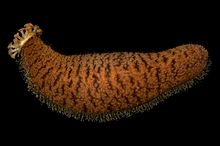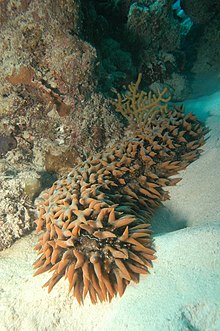| Sea cucumber Temporal range:
| |
|---|---|

| |
| A sea cucumber (Actinopyga echinites), displaying its feeding tentacles and tube feet | |
| Scientific classification | |
| Kingdom: | Animalia |
| Phylum: | Echinodermata |
| Subphylum: | Echinozoa |
| Class: | Holothuroidea Blainville, 1834 |
| Orders | |
| |
Sea cucumbers are echinoderms from the class Holothuroidea (/ˌhɒləˌθjʊəˈrɔɪdi.ə, ˌhoʊ-/). They are marine animals with a leathery skin and an elongated body containing a single, branched gonad. Sea cucumbers are found on the sea floor worldwide. The number of holothurian (/ˌhɒləˈθjʊəri.ən, ˌhoʊ-/)[1][2] species worldwide is about 1,717,[3] with the greatest number being in the Asia-Pacific region.[4] Many of these are gathered for human consumption and some species are cultivated in aquaculture systems. The harvested product is variously referred to as trepang, namako, bêche-de-mer, or balate. Sea cucumbers serve a useful role in the marine ecosystem as they help recycle nutrients, breaking down detritus and other organic matter, after which bacteria can continue the decomposition process.[4]
Like all echinoderms, sea cucumbers have an endoskeleton just below the skin, calcified structures that are usually reduced to isolated microscopic ossicles (or sclerietes) joined by connective tissue. In some species these can sometimes be enlarged to flattened plates, forming an armour. In pelagic species such as Pelagothuria natatrix (order Elasipodida, family Pelagothuriidae), the skeleton is absent and there is no calcareous ring.[5]
Sea cucumbers are named for their resemblance to the fruit of the cucumber plant.
https://en.wikipedia.org/wiki/Sea_cucumber

No comments:
Post a Comment